英语国家概况New_Zealand-修订版.pdf
- 格式:pdf
- 大小:4.46 MB
- 文档页数:29

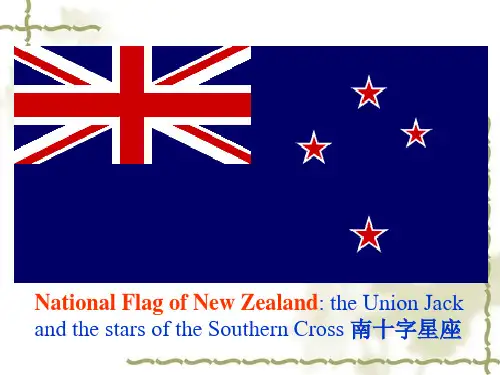
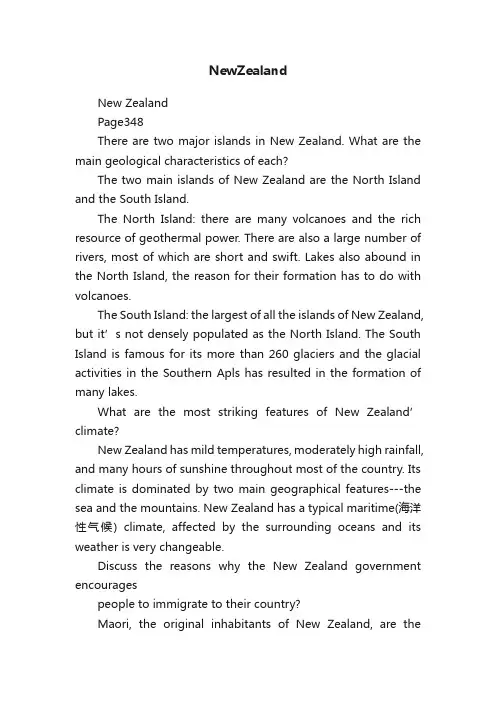
NewZealandNew ZealandPage348There are two major islands in New Zealand. What are the main geological characteristics of each?The two main islands of New Zealand are the North Island and the South Island.The North Island: there are many volcanoes and the rich resource of geothermal power. There are also a large number of rivers, most of which are short and swift. Lakes also abound in the North Island, the reason for their formation has to do with volcanoes.The South Island: the largest of all the islands of New Zealand, but it’s not densely populated as the North Island. The South Island is famous for its more than 260 glaciers and the glacial activities in the Southern Apls has resulted in the formation of many lakes.What are the most striking features of New Zealand’ climate?New Zealand has mild temperatures, moderately high rainfall, and many hours of sunshine throughout most of the country. Its climate is dominated by two main geographical features---the sea and the mountains. New Zealand has a typical maritime(海洋性气候) climate, affected by the surrounding oceans and its weather is very changeable.Discuss the reasons why the New Zealand government encouragespeople to immigrate to their country?Maori, the original inhabitants of New Zealand, are thelargest non-Europe group. They are a Polynesian people, whose ancestors first settled the islands in about the year of 1100. Their share of the population declined in the 19th century after European colonization of the island. Large-scale Pacific Island immigration began in the 1960s. East Asian immigration dates back to the 1860s, when gold rushed attracted thousands of Chinese to come. Another wave of immigration began in the 1980s by people from East and Southeast Asia.New Zealand is positive about immigration and is committed to increasing its population by approximately.Page358What do the words ‘Maori’ and ‘Pakeha’ mean?The name “Maori”originally meant “the local people”or “the original people”, while the name “Pekeha” is a term used to refer a New Zealand or European descent, or a non-Maori New Zealand.What’s the difference between dominion and realm?Before 1949, the term “dominion”was used officially to describe the self-governing countries of the Commonwealth of Nations. This was demonstrated in the proclamation of Queen Elizabeth II’s new titles in1953, where she was to be called Queen “of her Realms and Territories”, thereby replacing “dominion” with another mediaeval French word with the same connotation, “realm”(from royaume). Today, the former Dominions of the Empire(including the UK) are known as Realms of the Commonwealth.What does ‘ANZAC’ mean? What is ANZAC Day for?ANZAC is an acronym for Australia and New Zealand Army Corps, honors the nation’s armed forces that have fought inwars.Page 369In what way(s)does the legislative branch of New Zealand differ from that of Australia?The parliament of New Zealand is the legislature of New Zealand. It formally consists of the Queen and the House of Representatives, which means there is only one House instead of two House, where differ from Australia Parliament.The New Zealand government has always attached great importance to foreign trade. Discuss the crucial role foreign trade play in New Zealand’ live?First, one of the most distinctive features of the New Zealand economy isits reliance on international trade to drive growth. Exported goods and services approximately account for a third of the total output of the country. The country is depended on exports to buy imports of oil and a wide range of manufactured and consumer goods.Second, world prices for New Zealand’s primary products have not kept up with the prices of goods since that New Zealand imports. The country has sought to diversity its product offering and trading partners since the early 1970s in response to changing world demand and prices.Third, New Zealand major export destinations are Australia, Japan, the United Kingdom, the United States, and South Korea. The key export groups by order of importance are dairy products, meat, timber, and fish. The main sources of imports are Australia, the United States, Japan, China, and Germany. The most imports are mechanical, vehicles, electrical machinery, and mineral fuels. Imports of unprocessed products, notably metals and unrefinedpetroleum, are also significant.。
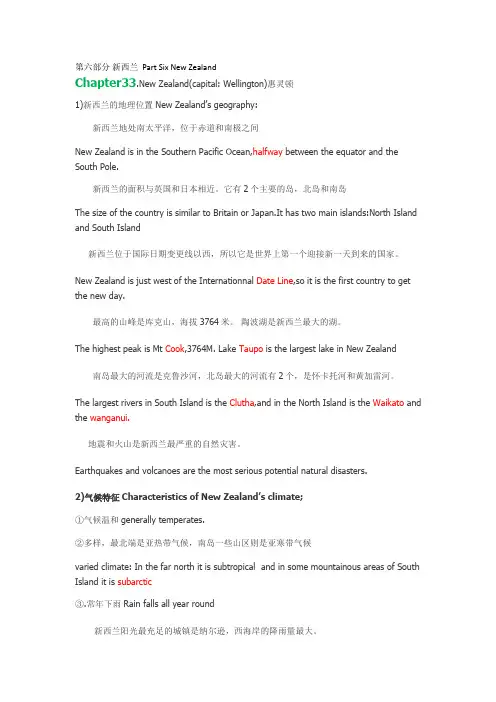
第六部分新西兰 Part Six New ZealandChapter33.New Zealand(capital: Wellington)惠灵顿1)新西兰的地理位置New Zealand’s geography:新西兰地处南太平洋,位于赤道和南极之间New Zealand is in the Southern Pacific Ocean,halfway between the equator and the South Pole.新西兰的面积与英国和日本相近。
它有2个主要的岛,北岛和南岛The size of the country is similar to Britain or Japan.It has two main islands:North Island and South Island新西兰位于国际日期变更线以西,所以它是世界上第一个迎接新一天到来的国家。
New Zealand is just west of the Internationnal Date Line,so it is the first country to get the new day.最高的山峰是库克山,海拔3764米。
陶波湖是新西兰最大的湖。
The highest peak is Mt Cook,3764M. Lake Taupo is the largest lake in New Zealand 南岛最大的河流是克鲁沙河,北岛最大的河流有2个,是怀卡托河和黄加雷河。
The largest rivers in South Island is the Clutha,and in the North Island is the Waikato and the wanganui.地震和火山是新西兰最严重的自然灾害。
Earthquakes and volcanoes are the most serious potential natural disasters.2)气候特征Characteristics of New Zealand’s climate;①气候温和generally temperates.②多样,最北端是亚热带气候,南岛一些山区则是亚寒带气候varied climate: In the far north it is subtropical and in some mountainous areas of South Island it is subarctic③.常年下雨Rain falls all year round新西兰阳光最充足的城镇是纳尔逊,西海岸的降雨量最大。

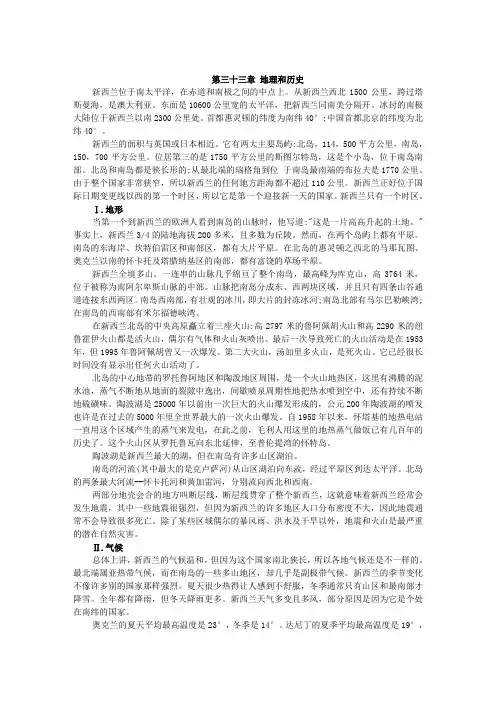
第三十三章地理和历史新西兰位于南太平洋,在赤道和南极之间的中点上。
从新西兰西北1500公里,跨过塔斯曼海,是澳大利亚。
东面是10600公里宽的太平洋,把新西兰同南美分隔开。
冰封的南极大陆位于新西兰以南2300公里处。
首都惠灵顿的纬度为南纬40°;中国首都北京的纬度为北纬40°。
新西兰的面积与英国或日本相近。
它有两大主要岛屿:北岛,114,500平方公里,南岛,150,700平方公里。
位居第三的是1750平方公里的斯图尔特岛,这是个小岛,位于南岛南部。
北岛和南岛都是狭长形的;从最北端的瑞格角到位于南岛最南端的布拉夫是1770公里。
由于整个国家非常狭窄,所以新西兰的任何地方距海都不超过110公里。
新西兰正好位于国际日期变更线以西的第一个时区,所以它是第一个迎接新一天的国家。
新西兰只有一个时区。
Ⅰ.地形当第一个到新西兰的欧洲人看到南岛的山脉时,他写道:"这是一片高高升起的土地。
"事实上,新西兰3/4的陆地海拔200多米,且多数为丘陵。
然而,在两个岛屿上都有平原。
南岛的东海岸、坎特伯雷区和南部区,都有大片平原。
在北岛的惠灵顿之西北的马那瓦图、奥克兰以南的怀卡托及塔腊纳基区的南部,都有富饶的草场平原。
新西兰全境多山。
一连串的山脉几乎绵亘了整个南岛,最高峰为库克山,高3764米,位于被称为南阿尔卑斯山脉的中部。
山脉把南岛分成东、西两块区域,并且只有四条山谷通道连接东西两区。
南岛西南部,有壮观的冰川,即大片的封冻冰河;南岛北部有马尔巴勒峡湾;在南岛的西南部有米尔福德峡湾。
在新西兰北岛的中央高原矗立着三座火山:高2797米的鲁阿佩胡火山和高2290米的纽鲁霍伊火山都是活火山,偶尔有气体和火山灰喷出。
最后一次导致死亡的火山活动是在1953年,但1995年鲁阿佩胡曾又一次爆发。
第二大火山,汤加里多火山,是死火山。
它已经很长时间没有显示出任何火山活动了。
北岛的中心地带的罗托鲁阿地区和陶泼地区周围,是一个火山地热区,这里有沸腾的泥水池,蒸气不断地从地面的裂隙中逸出,间歇喷泉周期性地把热水喷到空中,还有持续不断地硫磺味。


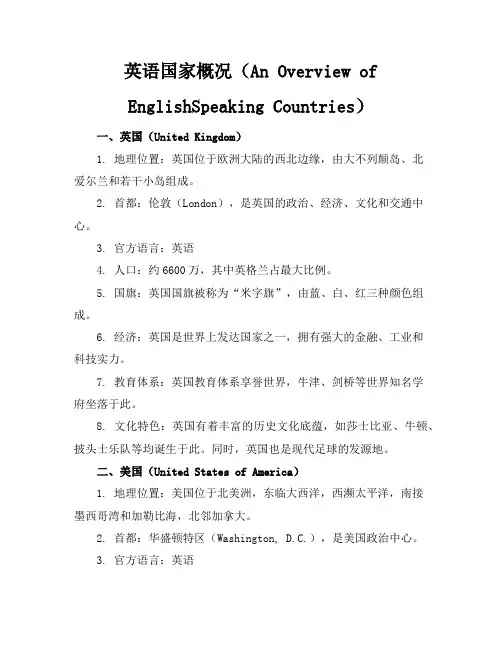
英语国家概况(An Overview ofEnglishSpeaking Countries)一、英国(United Kingdom)1. 地理位置:英国位于欧洲大陆的西北边缘,由大不列颠岛、北爱尔兰和若干小岛组成。
2. 首都:伦敦(London),是英国的政治、经济、文化和交通中心。
3. 官方语言:英语4. 人口:约6600万,其中英格兰占最大比例。
5. 国旗:英国国旗被称为“米字旗”,由蓝、白、红三种颜色组成。
6. 经济:英国是世界上发达国家之一,拥有强大的金融、工业和科技实力。
7. 教育体系:英国教育体系享誉世界,牛津、剑桥等世界知名学府坐落于此。
8. 文化特色:英国有着丰富的历史文化底蕴,如莎士比亚、牛顿、披头士乐队等均诞生于此。
同时,英国也是现代足球的发源地。
二、美国(United States of America)1. 地理位置:美国位于北美洲,东临大西洋,西濒太平洋,南接墨西哥湾和加勒比海,北邻加拿大。
2. 首都:华盛顿特区(Washington, D.C.),是美国政治中心。
3. 官方语言:英语4. 人口:约3.3亿,是世界上第三人口大国。
5. 国旗:美国国旗被称为“星条旗”,由红、白、蓝三种颜色组成。
6. 经济:美国是全球最大的经济体,拥有强大的科技创新能力和金融市场。
7. 教育体系:美国教育资源丰富,世界顶尖大学如哈佛、斯坦福等均位于此。
8. 文化特色:美国文化多元化,涵盖了欧洲、亚洲、非洲等多种文化元素。
好莱坞电影、NBA篮球、美式足球等在全球具有广泛影响力。
三、加拿大(Canada)1. 地理位置:加拿大位于北美洲北部,东临大西洋,西濒太平洋,北接北冰洋,南邻美国。
2. 首都:渥太华(Ottawa),是加拿大的政治中心。
3. 官方语言:英语和法语4. 人口:约3800万,是世界上面积第二大国家。
5. 国旗:加拿大国旗被称为“枫叶旗”,由红、白两色组成。
6. 经济:加拿大经济发达,资源丰富,特别是石油、天然气和矿产资源。
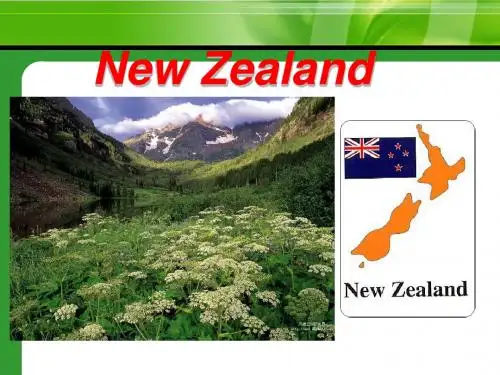
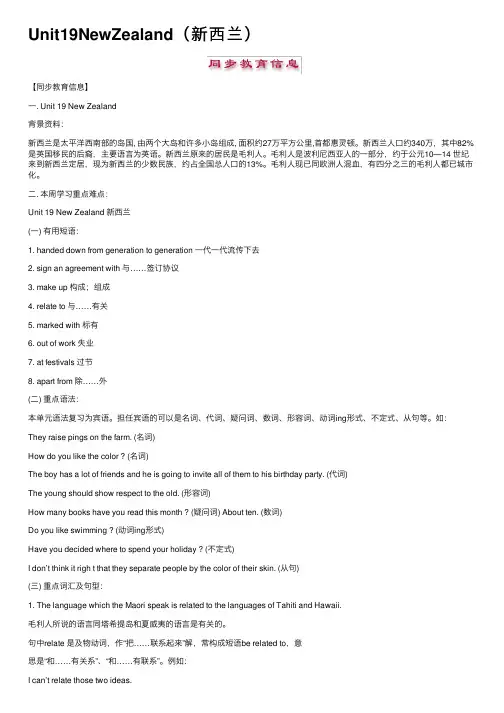
Unit19NewZealand(新西兰)【同步教育信息】⼀. Unit 19 New Zealand背景资料:新西兰是太平洋西南部的岛国, 由两个⼤岛和许多⼩岛组成, ⾯积约27万平⽅公⾥,⾸都惠灵顿。
新西兰⼈⼝约340万,其中82%是英国移民的后裔,主要语⾔为英语。
新西兰原来的居民是⽑利⼈。
⽑利⼈是波利尼西亚⼈的⼀部分,约于公元10—14 世纪来到新西兰定居,现为新西兰的少数民族,约占全国总⼈⼝的13%。
⽑利⼈现已同欧洲⼈混⾎,有四分之三的⽑利⼈都已城市化。
⼆. 本周学习重点难点:Unit 19 New Zealand 新西兰(⼀) 有⽤短语:1. handed down from generation to generation ⼀代⼀代流传下去2. sign an agreement with 与……签订协议3. make up 构成;组成4. relate to 与……有关5. marked with 标有6. out of work 失业7. at festivals 过节8. apart from 除……外(⼆) 重点语法:本单元语法复习为宾语。
担任宾语的可以是名词、代词、疑问词、数词、形容词、动词ing形式、不定式、从句等。
如:They raise pings on the farm. (名词)How do you like the color ? (名词)The boy has a lot of friends and he is going to invite all of them to his birthday party. (代词)The young should show respect to the old. (形容词)How many books have you read this month ? (疑问词) About ten. (数词)Do you like swimming ? (动词ing形式)Have you decided where to spend your holiday ? (不定式)I don’t think it righ t that they separate people by the color of their skin. (从句)(三) 重点词汇及句型:1. The language which the Maori speak is related to the languages of Tahiti and Hawaii.⽑利⼈所说的语⾔同塔希提岛和夏威夷的语⾔是有关的。
New Zealand / AotearoaSymbolsFlag∙The Union flag is in the top cornero Shows loyalty to Britain∙Southern Crosso A constellation seen in the Southern hemisphereNational Anthem∙“God Save the Queen”∙“God Defend New Zealand”o Both in English and MaoriNational Symbol∙The Kiwi – a flightless birdThe Land and the PeopleLocated in the Pacific OceanNorth Island∙Auckland – the largest city∙Wellington – the capital city∙There are many volcanoes on the island∙There are four volcanic mountainso Mount Egmont – most famouso Mount Ruapehu – the highest mountaino Mount Ngauruhoe – most activeo Mount Tonngariro – smallest mountain∙Swift rivers∙Hot springs∙Craters∙Energyo Geothermalo Hydro-electricSouth Island∙The most impressive mountains∙Glacierso Form lakes and riversClimate∙Mild temperatures∙High rainfall∙Many hours of sunshine∙The mountains influence the weathero Western side is very weto Eastern side is very dryPlants and Animals∙Geographic isolation and weather has led to the evolution of unique species only found on New Zealand!∙Almost no native mammals∙An abundance of different birds∙ A diversity of marine life∙The Kiwi – the National Symbol of NZ∙Kakapo – worlds largest parrot∙Tuatara – only beak-headed reptile∙Hector’s dolphinso The world’s largest dolphinso Only found in New ZealandPeople∙Population – 4.24 million peopleo¾ live on the North Islando85.4% live in urban areaso80% are of mixed European descent▪English, Scottish, Irish, German, etc.∙Maorio Largest non-European group (15%)o Original inhabitants (around 1100)o Polynesian∙Official Languageso English and Maori∙No state religion (freedom of religion)o40% have no religious affiliation▪Number is growing∙Dominate religion is Christianityo In declineHistory and the PresentMaori∙Descendants from the first Polynesian settlers around 1000AD∙Named the land AotearoaEuropean∙Dutch explorer Abel Tasman was the first European to discover NZ in 1642∙British explorer Captain James Cook mapped the island in 1796∙Newcomers were called Pakeha by the Maori∙The Pakeha were missionaries, traders, whalers, and sealersTreaty of Waitangi∙Attempt to ease tensions between the Maori and the colonists∙Signed in 1840∙The Maori chiefs give the British Queen governance of the islands∙The Queen’s representatives promise Maori ownership of the ir land, forests and fisheries ∙And gave the Maori the rights of British citizens∙Waitangi Day, New Zealand’s national day1840∙Britain establish first settlement at Wellington∙Land wars break out∙British ignore the Treaty and take land from the Maori∙By 1890, Maori own less than 1/6of New ZealandThe growth of a nation∙New Zealand Constitution Acto Establishes an independent government in 1852o General assemblyo Legislative councilo Elected house of representatives∙New Zealand officially becomes a dominion in 1907Late 19th Century∙Economic growtho The discovery of goldo Economy based on agricultureo Overseas trade in wool, meat, and dairy∙Progressive reformso1st country to allow women to vote in 1983o1st country to provide a pension to elderly people in 1898Modernization∙Full independence from Britain in 1947∙Economy continues to be based on agriculture∙Electoral reforms in 1993∙Minority parties are given better representation in parliamentRecreation∙Sportso British sports like rugby, cricket, netballo Unique geography makes skiing, hiking, skydiving, swimming, and fishing popular.∙Spend time in summer homes called “bachs” or “cribs”Maoritanga∙Rich and varied traditions of the Maori people∙Based on cooperation, loyalty, pride, and respect∙Maori are the official host people of New Zealand。
Chapter 34 New Zealand TodayThe population of New Zealand is 3.5 million. Approximately大约10 % are Maori, or part Maori. In spite of 尽管New Zealand's dependence on 依赖agriculture, most people live in towns and cities. About 55 % live in the seven urban centres of Auckland奥克兰, Wellington惠灵顿, Christchurch克赖斯特彻奇, Dunedin达尼丁, Hamilton哈密尔顿, Palmerston North北帕默斯顿and Napier-Hastings 纳皮尔——哈斯廷斯. The populations of the four main centres are Auckland 890,000, Wellington 330,000, Christchurch 310,000, Dunedin 110,000.新西兰的人口350万。
大约10%的人为毛利人或有部分毛利血统的人。
尽管新西兰依赖于农业,但大多数人还是居住在城镇和城市里。
大约55%的人住在七个大城市中:奥克兰、惠灵顿、克赖斯特彻奇、达尼丁、哈密尔顿,北帕默斯顿和纳皮尔——哈斯廷斯。
四个主要城市的人口分别为:奥克兰,89 O.000人;惠灵顿,330,000人;克赖斯特彻奇,310,000人;达尼丁,11 O.000人Nearly three fourths 3/4of the people live in North Island, with over 50% of New Zealanders living north of Hamilton. Reasons for this uneven distribution分布不均are the milder 更暖climate in the north, the expansion膨胀of North Island industries and the availability适合于of land suitable for specialized farming.特殊耕作近3/4的人住在北岛,50%的新西兰人住在哈密尔顿以北。